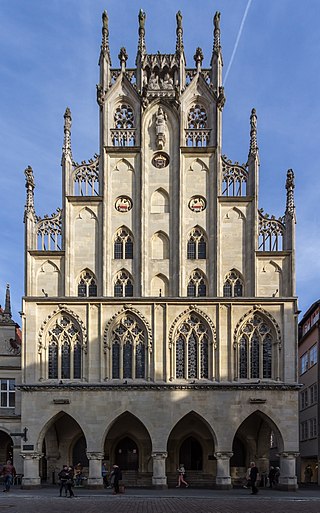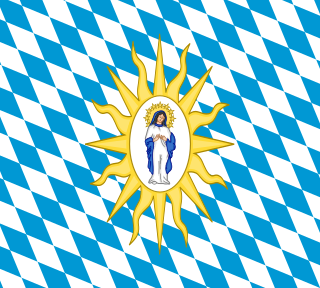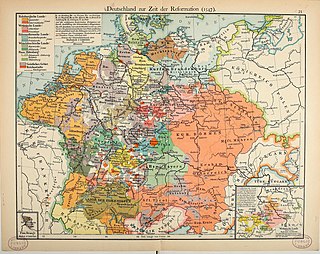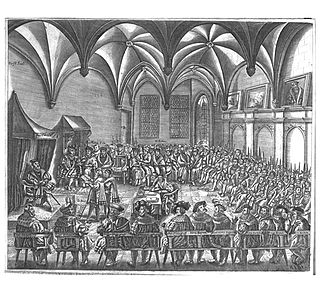
The Peace of Westphalia is the collective name for two peace treaties signed in October 1648 in the Westphalian cities of Osnabrück and Münster. They ended the Thirty Years' War (1618–1648) and brought peace to the Holy Roman Empire, closing a calamitous period of European history that killed approximately eight million people. Holy Roman Emperor Ferdinand III, the kingdoms of France and Sweden, and their respective allies among the princes of the Holy Roman Empire, participated in the treaties.

The Thirty Years' War was one of the longest and most destructive conflicts in European history, lasting from 1618 to 1648. Fought primarily in Central Europe, an estimated 4.5 to 8 million soldiers and civilians died as a result of battle, famine, or disease, while parts of modern Germany reported population declines of over 50%. Related conflicts include the Eighty Years' War, the War of the Mantuan Succession, the Franco-Spanish War, the Torstenson War, the Dutch-Portuguese War, and the Portuguese Restoration War.

Ferdinand I was Holy Roman Emperor from 1556, King of Bohemia, Hungary, and Croatia from 1526, and Archduke of Austria from 1521 until his death in 1564. Before his accession as emperor, he ruled the Austrian hereditary lands of the House of Habsburg in the name of his elder brother, Charles V, Holy Roman Emperor. Also, he often served as Charles' representative in the Holy Roman Empire and developed encouraging relationships with German princes. In addition, Ferdinand also developed valuable relationships with the German banking house of Jakob Fugger and the Catalan bank, Banca Palenzuela Levi Kahana.

The Schmalkaldic League was a military alliance of Lutheran princes within the Holy Roman Empire during the mid-16th century. It received its name from the town of Schmalkalden, which is located in modern Thuringia.

The Catholic League was a coalition of Catholic states of the Holy Roman Empire formed 10 July 1609. While initially formed as a confederation to act politically to negotiate issues vis-à-vis the Protestant Union, modelled on the more intransigent ultra-Catholic French Catholic League (1576), it was subsequently concluded as a military alliance "for the defence of the Catholic religion and peace within the Empire".

The Protestant Union, also known as the Evangelical Union, Union of Auhausen, German Union or the Protestant Action Party, was a coalition of Protestant German states. It was formed on 14 May 1608 by Frederick IV, Elector Palatine in order to defend the rights, land and safety of each member. It included both Calvinist and Lutheran states, and dissolved in 1621.

The Peace of Augsburg, also called the Augsburg Settlement, was a treaty between Charles V, Holy Roman Emperor, and the Schmalkaldic League, signed on 25 September 1555 at the imperial city of Augsburg. It officially ended the religious struggle between the two groups and made the legal division of Christianity permanent within the Holy Roman Empire, allowing rulers to choose either Lutheranism or Roman Catholicism as the official confession of their state. Calvinism was not allowed until the Peace of Westphalia.

Cuius regio, eius religio is a Latin phrase which literally means "whose realm, their religion" – meaning that the religion of the ruler was to dictate the religion of those ruled. This legal principle marked a major development in the collective freedom of religion within Western civilization. Before tolerance of individual religious divergences became accepted, most statesmen and political theorists took it for granted that religious diversity weakened a state – and particularly weakened ecclesiastically-transmitted control and monitoring in a state. The principle of "cuius regio" was a compromise in the conflict between this paradigm of statecraft and the emerging trend toward religious pluralism developing throughout the German-speaking lands of the Holy Roman Empire. It permitted assortative migration of adherents to two religious groups, Roman Catholic and Lutheran, eliding other confessions.

The Schmalkaldic War was the short period of violence from 1546 until 1547 between the forces of Emperor Charles V of the Holy Roman Empire, commanded by the Duke of Alba and the Duke of Saxony, and the Lutheran Schmalkaldic League within the domains of the Holy Roman Empire.

The Edict of Restitution was proclaimed by Ferdinand II, Holy Roman Emperor in Vienna, on 6 March 1629, eleven years into the Thirty Years' War. Following Catholic military successes, Ferdinand hoped to restore control of land to that specified in the Peace of Augsburg (1555). That treaty's "Ecclesiastical Reservation" had prohibited further secularization of lands held by the Catholic church after 1555, disallowing any transfer of such lands to Protestant control. However, as the Holy Roman Empire descended into the Thirty Years' War, weak emperors had been unable to enforce this provision against Protestant encroachments.

The Peace of Prague, signed on 30 May 1635, ended Saxony's participation in the Thirty Years War. Other German princes subsequently joined the treaty and although the Thirty Years War continued, it is generally agreed Prague ended it as a war of religion within the Holy Roman Empire. Thereafter, the conflict was largely driven by foreign powers, including Spain, Sweden, and France.

The Augsburg Interim was an imperial decree ordered on 15 May 1548 at the 1548 Diet of Augsburg by Charles V, Holy Roman Emperor, who had just defeated the forces of the Protestant Schmalkaldic League in the Schmalkaldic War of 1546/47. Although it ordered Protestants to readopt traditional Catholic beliefs and practices, including the seven Sacraments, it allowed for Protestant clergymen the right to marry and for the laity to receive communion in both kinds. It is considered the first significant step in the process leading to the political and religious legitimization of Protestantism as a valid alternative Christian creed to Roman Catholicism finally realized in the 1552 Peace of Passau and the 1555 Peace of Augsburg. The Interim became Imperial law on 30 June 1548. The Pope advised all bishops to abide by the concessions made to the Protestants in the Interim in August 1549.

The European wars of religion were a series of wars waged in Europe during the 16th, 17th and early 18th centuries. Fought after the Protestant Reformation began in 1517, the wars disrupted the religious and political order in the Catholic countries of Europe, or Christendom. Other motives during the wars involved revolt, territorial ambitions and great power conflicts. By the end of the Thirty Years' War (1618–1648), Catholic France had allied with the Protestant forces against the Catholic Habsburg monarchy. The wars were largely ended by the Peace of Westphalia (1648), which established a new political order that is now known as Westphalian sovereignty.

The German-speaking states of the early modern period were divided politically and religiously. Religious tensions between the states comprising the Holy Roman Empire had existed during the preceding period of the Late Middle Ages, notably erupting in Bohemia with the Hussite Wars (1419–1434). The defining religious movement of this period, the Reformation, led to unprecedented levels of violence and political upheaval for the region.

The reservatum ecclesiasticum was a provision of the Peace of Augsburg of 1555. It exempted ecclesiastical lands from the principle of cuius regio, eius religio, which the Peace established for all hereditary dynastic lands, such as those ruled by princes or dukes. Under this principle, the religion of the ruler would be the religion of the country and of its people, those being his possession by inheritance.

The history of religious pluralism is the fruit of a long development that reaches from antiquity to contemporary trends in postmodernity.

The Cologne War was a conflict between Protestant and Catholic factions that devastated the Electorate of Cologne, a historical ecclesiastical principality of the Holy Roman Empire, within present-day North Rhine-Westphalia, in Germany. The war occurred within the context of the Protestant Reformation in Germany and the subsequent Counter-Reformation, and concurrently with the Dutch Revolt and the French Wars of Religion.

The Treaty of Bärwalde, signed on 23 January 1631, was an agreement by France to provide Sweden financial support, following its intervention in the Thirty Years' War.
An imperial election was held in Regensburg on 28 November 1562 to select the emperor of the Holy Roman Empire.
The imperial election of 1653 was an imperial election held to select the emperor of the Holy Roman Empire. It took place in Augsburg on May 31.

















